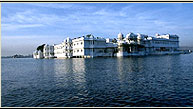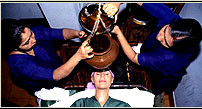-| Bodhgaya | -
Location: District Gaya (Bihar) - Lat 24º 42'N ; 85º 0'E

Bodhgaya is located 12 km. from Gaya. 245 Kms. from Varanasi & 178 Kms.
from Patna via Rajgir.
Bodhgaya is the most important Buddhist pilgrimage centre. This is the place
where Lord Sakyamuni or Gautam Buddha entered into meditation after being moved
by the suffering of mankind. The giant Bodhi or Peepal tree under which, sitting
on raised platform, Prince Siddharth meditated and finally attained Nirvana.
Then, there is a Chaukramana, the Jewel walk, where it is believed that Buddha
strolled while in deep thought. The magnificence of Mahabodhi temple is an amalgamation
of many cultures. The temple mainly bears the stamp of the architecture of Gupta
dynasty (4th to 6th AD) and subsequent ages. The wall has many niches which
have been embellished with figures of Buddha in various postures. The sanctum-sanctorum
has colossal Buddha in a Bhumi sparsh Mudra. The temple carries inscriptions
recording the visit of pilgrims from Srilanka, China and Myanmar in the 7th
to 10th century AD. Hiuen Tsang, the Chinese traveler also visited the temple
in 7th century AD.
The holy spot gradually developed into an important Buddhist centre with numerous
temples, stupa and monasteries. Of the earliest shrines, only the Vajraasana
or the sandstone throne with the characteristic Mauryan age polish and decorative
designs has survived and can be seen beneath the sacred Bodhi tree. The main
brick Mahabodhi temple appears to have been erected in the second century BC.
However, this temple has undergone major restoration and renovation. The shrines
and votive stupas mostly belong to the Pala Period (9th to 11 the century AD).
In the recent years, a museum has been set up by ASI (Archaeological Survey
of India) housing loose sculptures and other antiquities from the site and its
neighbourhood. The buddhist sculpture collection from 1st century BC to 11th
century AD is housed in the Bodhgaya Archaeological museum is a mirror of Buddhist
art




